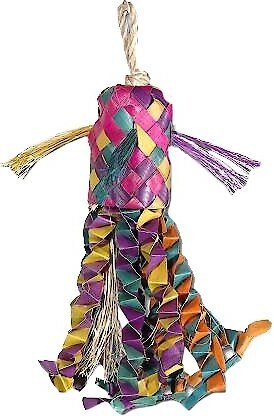Parakeets, also known as budgies, are one of the most vibrant and lively bird species. They are popular as pet birds because they are smart, inquisitive and easy to care for. If you have brought home a parakeet or have been thinking of adding a budgie to your family, you may have wondered can parakeets talk. And if yes, how to teach a parakeet to talk?
So, without further ado, let’s get to it.
Can Parakeets Talk?
Yes, parakeets are known for their talking abilities—they mimic the sounds of words produced by their owners. While most parakeets are only able to learn a few words, some can learn hundreds of words if taught and trained properly with patience.
Precisely speaking, these budgies cannot actually talk, owing to the absence of vocal cords. They merely mimic the sounds that they hear around them, be it of their flock chirping around or human parents talking.
Largest Vocabulary for a Bird!
Parakeets are one of the creatures that also hold a Guinness Book world record for the largest vocabulary for a bird ever. Largest vocabulary for a bird ever: Puck the Budgie knew 1728 words Largest vocabulary for a bird living: Oskar the Budgie could speak 148 words

How to Teach a Parakeet to Talk?
Parakeets are naturally vocal and social creatures. Their vocal abilities can be used for our delight by training them how to talk or speak short phrases.
The easiest birds to train are hand-raised, young, and of the male gender.
It can be time-consuming and a difficult process, requiring a lot of patience and persistence at your end, but can be thrilling.
Read: Do Parakeets like Music
Age and Gender
Brains are more receptive and flexible at a young age. Therefore, invest in a young parakeet while it’s still developing its communication skills. Males are generally more likely to learn how to speak much faster and easier, as compared to their female counterparts. This may be because they need to draw the attention of females due to reproductive reasons. Thus, it’ll be a good idea to devote your time and energy to teaching a young male rather than a young female.
Parakeet Gender Identification!
While female parakeets cere—raised fleshy skin around their nostrils—is colored white, pink, or pale blue, which turns into darker tan or brownish color when they are fertile, male parakeets have bright purple-colored cere, which turns to royal or bright blue when budgies are in the mood to mate.
Stationing
The location—and type of cage you keep your bird in—plays an important role in its bonding with you and how long it takes for the bird to learn new words.
The cage should be big enough and placed where the bird can socialize and connect with the owners daily. Also, keep a limited amount of budgies, as it will then communicate more with other birds instead of communicating with you.
Time of the Day
It is a well-known fact that humans’ brains work the best in the morning; the same is the case with birds. Your feathery fellow will learn best in the morning after having a good sleep and meal. Satiety makes minds more receptive. Furthermore, parakeets are much more alert in the morning.
Read: How do Parakeets Sleep?
Bonding
Creating a trustworthy and affectionate bond with your pet bird is equally important for it to memorize new words. Parakeets are warm and friendly birds. To learn a new language, they must feel the need to communicate with you—and for this, you must build a friendly relationship with them. Give them ample amount of time in a day—talking, singing, providing them toys to play with. You can also let your budgie out of its cage once it’s comfortable with you.
Bird Toys For Parakeets,5pcs Parrot Toys Set
|
|
Use Simple Words
Although Parakeets are intelligent and inquisitive birds, human language is not their innate language. For them, a human talking and the doorbell ringing are merely two different sounds in the environment. They don’t talk but simply mimic or imitate.
Budgies are good with the consonants D, T, K, P, and B. It would be convenient and admirable to teach your bird its name first. But for that, you must choose a simple name like Kirby, Belle, Roy, Pixie, Tony.
Easy words to teach a parakeet
From the above discussion, it would have become obvious to you that you should teach only one word at a time to your parakeet. While parakeets can learn about any word with enough repetition, it is comparatively a lot easier to teach them how to say simple words with simpler pronunciation. For instance, parakeets are known to learn simple words like “cutie,” “sweet,” “kiss,” “hello,” “hola,” “night-night,” “bye,” “love,” etc. All these words are short and simple so, you should only move on to difficult words and phrases once your parakeet has mastered simple words.
Speak slowly and clearly to your bird, repeating the same word that you want it to learn again and again. Do not jump to another word as soon as your budgie learns the previous; keep repeating the word for a few days. After all, practice makes one perfect.
Parakeets cannot mimic long sentences like “hi, how are you?”, thus it’s better to stick to simple words.
Include your bird in your daily conversations like other family members. Greet it in the morning and while leaving. Eventually, they’ll start saying the words you used often.
Repetition and Consistency
Consistency and repetition is the key when learning new things. The same goes for when you’re teaching parakeets to talk. Speak to it regularly and at the same time each day. Be patient with them and never scold or punish them as you might end up scaring them off. Move on to the next word only when it has learned the previous one.
After your bird learns how to say words, you can move forward in teaching them the name of objects. Simply hold the object and say its name. For example, while giving them food, you can use the word “yum-yum.” This will help them recognize and associate this word with food.
Reward
To help condition your budgie, reward it with its favorite treats like grapes, blueberries, and millet sprays, whenever it says the word you’re teaching it. This will cause positive reinforcement and make your pet associate this behavior with a favorable response. Complimenting your bird with words like “sweet” and “good” will also reassure it that it’s doing a good job at learning.
Kaytee Spray Millet for Birds, 12 Count (Pack of 1)
|
|
Avoid Distractions
Cover the sides of your bird’s cage with a cloth during its lessons so it can focus. Stand in front of the cage and face your budgie directly while teaching, so it knows you’re talking to it. Also, limit your training sessions to half an hour to avoid stressing or boring your bird.
How Long Does It Take To Teach a Parakeet to Talk?
Getting your parakeet talking is not an easy task—you will have to be repetitive, consistent, and calm. There is no fixed time or stage when parakeets start talking; different parakeets learn how to talk in different time periods—anywhere between two weeks to two months. For some, it could be up to six months or even more.
However, it becomes much easier to teach parakeets new words once they have learned a few words.
Final Verdict: Can Parakeets Talk?
Parakeets can learn how to talk—mimic word sounds that they have heard. However, teaching parakeets how to talk is a cumbersome task—requiring a lot of patience and consistency. That said, once a parakeet has learned a few words, learning new words becomes a lot easier—some parakeets can learn hundreds of words. Thus, if you’re deciding on keeping parakeets as pets, do not think twice. These birds will make your home considerably enjoyable, as they add colors and beautiful sounds to your surroundings.
Read: Are Parakeets Loud


